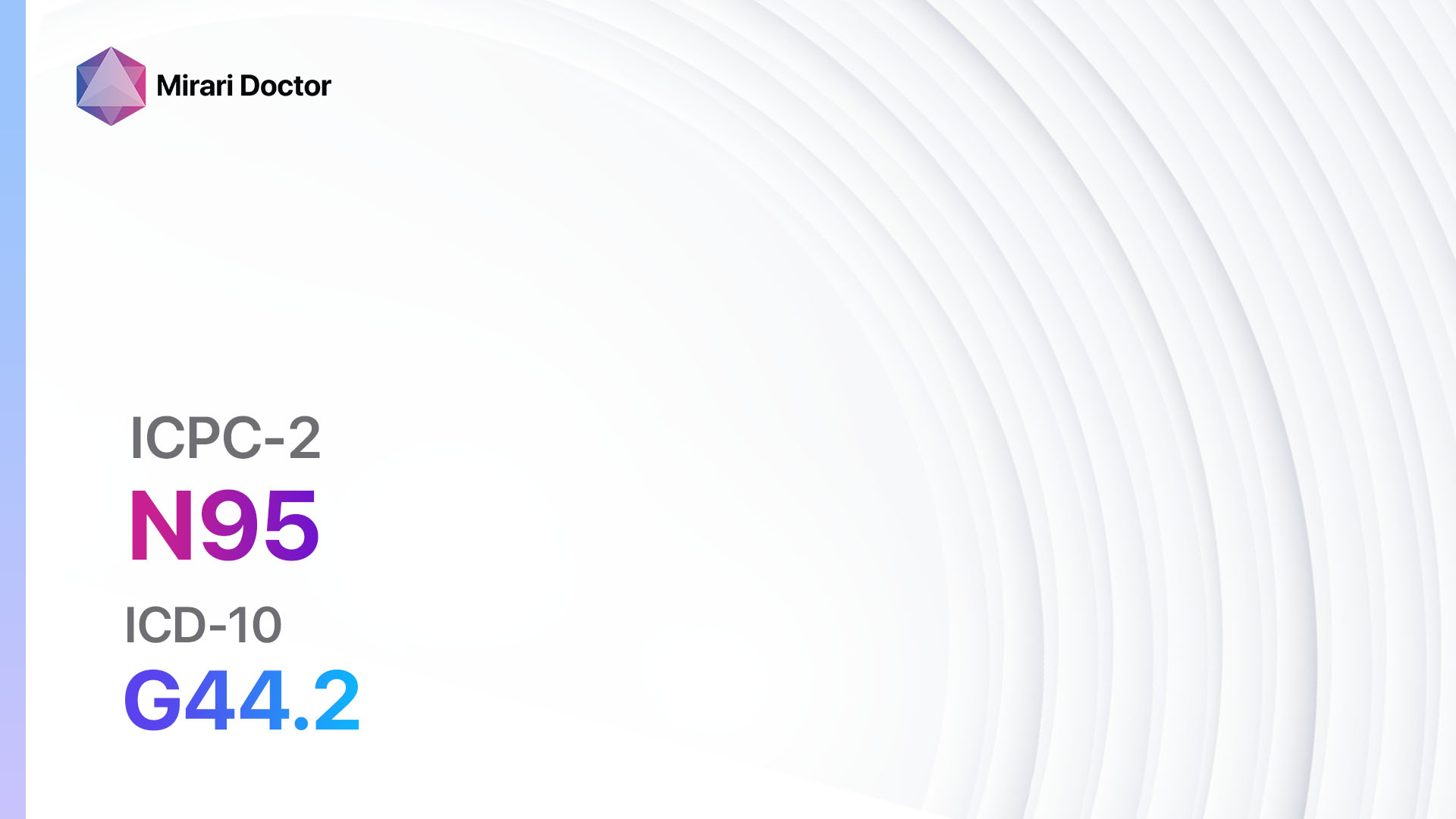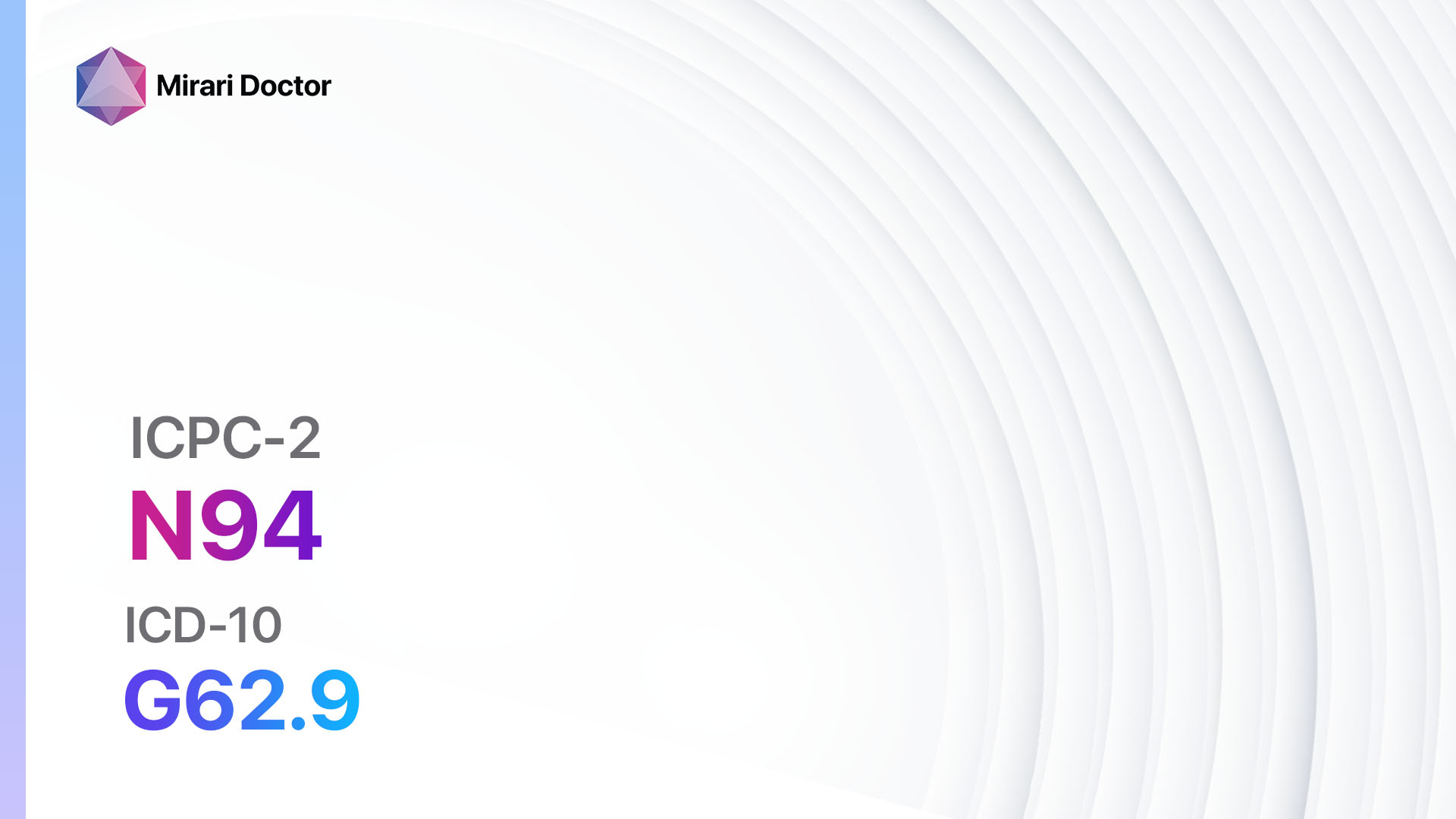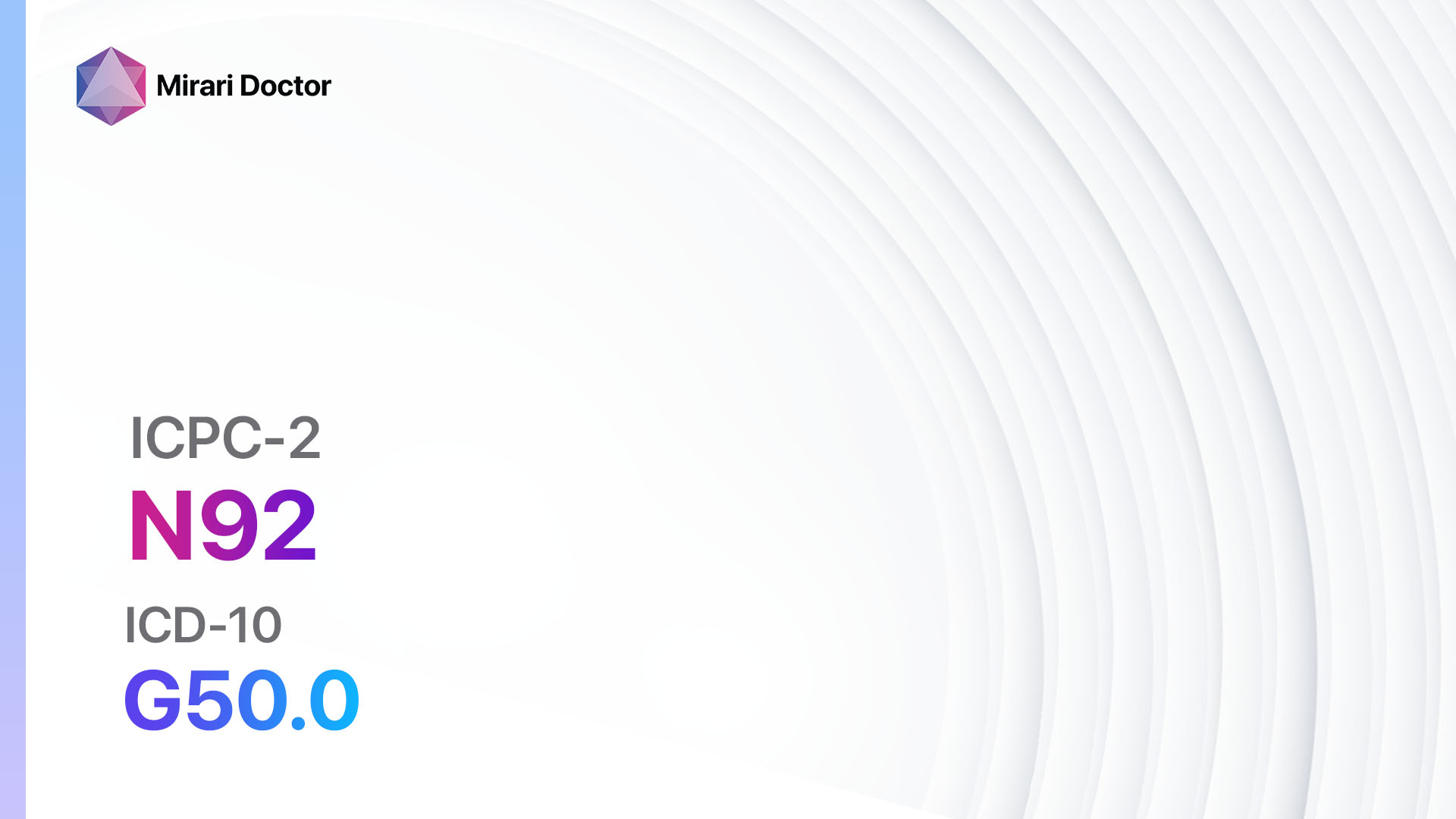
Introduction
Congenital anomaly neurological refers to a group of neurological disorders that are present at birth. These anomalies can affect the brain, spinal cord, nerves, or muscles, leading to various symptoms and functional impairments.[1] The aim of this guide is to provide an overview of the symptoms, causes, diagnostic steps, possible interventions, and lifestyle modifications for individuals with congenital anomaly neurological.
Codes
- ICPC-2 Code: N85 Congenital anomaly neurological[2]
- ICD-10 Code: Q07.9 Congenital malformation of nervous system, unspecified[3]
Symptoms
- Developmental delays: Delays in reaching developmental milestones, such as sitting, crawling, or walking.[4]
- Intellectual disability: Below-average intellectual functioning and difficulties with adaptive skills.
- Seizures: Recurrent episodes of abnormal electrical activity in the brain.
- Muscle weakness or paralysis: Weakness or inability to move certain muscles or muscle groups.
- Abnormal muscle tone: Increased or decreased muscle tone, leading to stiffness or floppiness.
- Speech and language difficulties: Delayed or impaired speech and language development.
- Vision or hearing problems: Impairments in vision or hearing abilities.
- Coordination and balance issues: Difficulties with coordination and balance, leading to unsteady movements.
- Behavioral problems: Hyperactivity, impulsivity, aggression, or self-injurious behaviors.[5]
Causes
- Genetic factors: Mutations or abnormalities in genes responsible for brain and nervous system development.
- Environmental factors: Exposure to toxins, infections, or certain medications during pregnancy.
- Maternal health conditions: Maternal diabetes, thyroid disorders, or substance abuse during pregnancy.
- Chromosomal abnormalities: Changes in the structure or number of chromosomes.[6]
Diagnostic Steps
Medical History
- Gather information about the patient’s prenatal, birth, and postnatal history.
- Identify any risk factors, such as maternal health conditions or exposure to toxins.
- Document the presence and progression of symptoms.[7]
Physical Examination
- Perform a thorough neurological examination to assess muscle strength, tone, reflexes, and coordination.
- Evaluate sensory functions, including vision, hearing, and touch.
- Assess developmental milestones and cognitive abilities.
- Look for any physical abnormalities, such as facial asymmetry or limb deformities.[8]
Laboratory Tests
- Genetic testing: Identify specific genetic mutations or chromosomal abnormalities.
- Metabolic screening: Rule out metabolic disorders that may present with similar symptoms.
- Blood tests: Assess for infections, nutritional deficiencies, or other underlying conditions.[9]
Diagnostic Imaging
- Magnetic Resonance Imaging (MRI): Visualize the brain and spinal cord to identify structural abnormalities.
- Computed Tomography (CT) scan: Provide detailed images of the brain to detect any abnormalities.
- Ultrasound: Used in infants to assess brain structure and detect any abnormalities.[10]
Other Tests
- Electroencephalogram (EEG): Record brain wave patterns to diagnose and monitor seizures.
- Vision and hearing tests: Assess the extent of vision or hearing impairments.
- Developmental assessments: Evaluate cognitive, language, and motor skills.
Follow-up and Patient Education
- Schedule regular follow-up appointments to monitor the progression of symptoms and adjust treatment plans.
- Provide education and support to the patient and their family regarding the condition, available interventions, and resources for assistance.
Possible Interventions
Traditional Interventions
Medications:
Top 5 drugs for Congenital anomaly neurological:
- Antiepileptic drugs (e.g., Valproic acid, Levetiracetam):
- Cost: Generic versions can range from $10 to $100 per month.
- Contraindications: Hypersensitivity to the drug, liver disease.
- Side effects: Drowsiness, dizziness, nausea.
- Severe side effects: Liver toxicity, pancreatitis.
- Drug interactions: Other antiepileptic drugs, oral contraceptives.
- Warning: Regular liver function tests required.
- Muscle relaxants (e.g., Baclofen, Diazepam):
- Cost: Generic versions can range from $10 to $50 per month.
- Contraindications: Hypersensitivity to the drug, liver disease.
- Side effects: Drowsiness, dizziness, weakness.
- Severe side effects: Respiratory depression, liver toxicity.
- Drug interactions: Other sedatives, alcohol.
- Warning: Avoid abrupt discontinuation.
- Stimulant medications (e.g., Methylphenidate, Amphetamine):
- Cost: Generic versions can range from $10 to $100 per month.
- Contraindications: Hypersensitivity to the drug, cardiovascular disease.
- Side effects: Increased heart rate, decreased appetite, insomnia.
- Severe side effects: Psychiatric symptoms, cardiovascular events.
- Drug interactions: Monoamine oxidase inhibitors (MAOIs), antihypertensive drugs.
- Warning: Regular monitoring of blood pressure and heart rate required.
- Antidepressant medications (e.g., Sertraline, Fluoxetine):
- Cost: Generic versions can range from $10 to $50 per month.
- Contraindications: Hypersensitivity to the drug, concurrent use of MAOIs.
- Side effects: Nausea, headache, sexual dysfunction.
- Severe side effects: Suicidal thoughts, serotonin syndrome.
- Drug interactions: MAOIs, other serotonergic drugs.
- Warning: Increased risk of suicidal thoughts in children and adolescents.
- Antipsychotic medications (e.g., Risperidone, Aripiprazole):
- Cost: Generic versions can range from $10 to $100 per month.
- Contraindications: Hypersensitivity to the drug, dementia-related psychosis.
- Side effects: Weight gain, sedation, extrapyramidal symptoms.
- Severe side effects: Neuroleptic malignant syndrome, tardive dyskinesia.
- Drug interactions: Other antipsychotic drugs, antihypertensive drugs.
- Warning: Increased risk of stroke in elderly patients with dementia.
Alternative Drugs :
- Baclofen pump: Implantation of a pump that delivers baclofen directly into the spinal fluid to manage muscle spasticity. Cost: $20,000 to $50,000.
- Botulinum toxin injections: Injecting botulinum toxin into specific muscles to reduce spasticity. Cost: $500 to $1,500 per injection.
- Selective dorsal rhizotomy: Surgical procedure to selectively cut sensory nerve fibers in the spinal cord to reduce spasticity. Cost: $50,000 to $100,000.
- Antiepileptic ketogenic diet: A high-fat, low-carbohydrate diet that can help control seizures. Cost: Varies depending on dietary needs and restrictions.
- Speech therapy: Helps improve speech and language skills. Cost: $100 to $200 per session.
Surgical Procedures:
- Orthopedic surgeries: Corrective surgeries to address musculoskeletal deformities or contractures. Cost: $10,000 to $50,000.
- Deep brain stimulation: Implantation of electrodes in the brain to manage movement disorders. Cost: $50,000 to $100,000.
- Vagus nerve stimulation: Implantation of a device that stimulates the vagus nerve to reduce seizures. Cost: $30,000 to $50,000.
Alternative Interventions
- Physical therapy: Helps improve muscle strength, coordination, and mobility. Cost: $100 to $200 per session.
- Occupational therapy: Focuses on improving daily living skills and fine motor abilities. Cost: $100 to $200 per session.
- Speech therapy: Helps improve speech and language skills. Cost: $100 to $200 per session.
- Aquatic therapy: Exercises performed in a pool to improve strength and mobility. Cost: $50 to $100 per session.
- Music therapy: Uses music to improve communication, social skills, and emotional well-being. Cost: $50 to $100 per session.
Lifestyle Interventions
- Nutritional counseling: Provides guidance on a balanced diet and appropriate calorie intake. Cost: $100 to $200 per session.
- Assistive devices: Wheelchairs, braces, or communication devices to enhance independence. Cost: Varies depending on the specific device.
- Behavioral therapy: Helps manage challenging behaviors and improve social skills. Cost: $100 to $200 per session.
- Parent training: Provides parents with strategies to support their child’s development and behavior. Cost: $100 to $200 per session.
- Support groups: Offer emotional support and resources for individuals and families. Cost: Varies depending on the organization or group.
It is important to note that the cost ranges provided are approximate and may vary depending on the location and availability of the interventions.
Mirari Cold Plasma Alternative Intervention
Understanding Mirari Cold Plasma
- Safe and Non-Invasive Treatment: Mirari Cold Plasma is a safe and non-invasive treatment option for various skin conditions. It does not require incisions, minimizing the risk of scarring, bleeding, or tissue damage.
- Efficient Extraction of Foreign Bodies: Mirari Cold Plasma facilitates the removal of foreign bodies from the skin by degrading and dissociating organic matter, allowing easier access and extraction.
- Pain Reduction and Comfort: Mirari Cold Plasma has a local analgesic effect, providing pain relief during the treatment, making it more comfortable for the patient.
- Reduced Risk of Infection: Mirari Cold Plasma has antimicrobial properties, effectively killing bacteria and reducing the risk of infection.
- Accelerated Healing and Minimal Scarring: Mirari Cold Plasma stimulates wound healing and tissue regeneration, reducing healing time and minimizing the formation of scars.
Mirari Cold Plasma Prescription
Video instructions for using Mirari Cold Plasma Device – N85 Congenital anomaly neurological (ICD-10:Q07.9)
| Mild | Moderate | Severe |
| Mode setting: 2 (Wound Healing) Location: 7 (Neuro system & ENT) Morning: 15 minutes, Evening: 15 minutes |
Mode setting: 2 (Wound Healing) Location: 7 (Neuro system & ENT) Morning: 30 minutes, Lunch: 30 minutes, Evening: 30 minutes |
Mode setting: 2 (Wound Healing) Location: 7 (Neuro system & ENT) Morning: 30 minutes, Lunch: 30 minutes, Evening: 30 minutes |
| Mode setting: 7 (Immunotherapy) Location: 1 (Sacrum) Morning: 15 minutes, Evening: 15 minutes |
Mode setting: 7 (Immunotherapy) Location: 1 (Sacrum) Morning: 30 minutes, Lunch: 30 minutes, Evening: 30 minutes |
Mode setting: 7 (Immunotherapy) Location: 1 (Sacrum) Morning: 30 minutes, Lunch: 30 minutes, Evening: 30 minutes |
| Mode setting: 7 (Immunotherapy) Location: 1 (Sacrum) Morning: 15 minutes, Evening: 15 minutes |
Mode setting: 7 (Immunotherapy) Location: 1 (Sacrum) Morning: 30 minutes, Lunch: 30 minutes, Evening: 30 minutes |
Mode setting: 7 (Immunotherapy) Location: 1 (Sacrum) Morning: 30 minutes, Lunch: 30 minutes, Evening: 30 minutes |
| Total Morning: 45 minutes approx. $7.50 USD, Evening: 45 minutes approx. $7.50 USD |
Total Morning: 90 minutes approx. $15 USD, Lunch: 90 minutes approx. $15 USD, Evening: 90 minutes approx. $15 USD, |
Total Morning: 90 minutes approx. $15 USD, Lunch: 90 minutes approx. $15 USD, Evening: 90 minutes approx. $15 USD, |
| Usual treatment for 7-60 days approx. $105 USD – $900 USD | Usual treatment for 6-8 weeks approx. $1,890 USD – $2,520 USD |
Usual treatment for 3-6 months approx. $4,050 USD – $8,100 USD
|
 |
|
Use the Mirari Cold Plasma device to treat Congenital anomaly neurological effectively.
WARNING: MIRARI COLD PLASMA IS DESIGNED FOR THE HUMAN BODY WITHOUT ANY ARTIFICIAL OR THIRD PARTY PRODUCTS. USE OF OTHER PRODUCTS IN COMBINATION WITH MIRARI COLD PLASMA MAY CAUSE UNPREDICTABLE EFFECTS, HARM OR INJURY. PLEASE CONSULT A MEDICAL PROFESSIONAL BEFORE COMBINING ANY OTHER PRODUCTS WITH USE OF MIRARI.
Step 1: Cleanse the Skin
- Start by cleaning the affected area of the skin with a gentle cleanser or mild soap and water. Gently pat the area dry with a clean towel.
Step 2: Prepare the Mirari Cold Plasma device
- Ensure that the Mirari Cold Plasma device is fully charged or has fresh batteries as per the manufacturer’s instructions. Make sure the device is clean and in good working condition.
- Switch on the Mirari device using the power button or by following the specific instructions provided with the device.
- Some Mirari devices may have adjustable settings for intensity or treatment duration. Follow the manufacturer’s instructions to select the appropriate settings based on your needs and the recommended guidelines.
Step 3: Apply the Device
- Place the Mirari device in direct contact with the affected area of the skin. Gently glide or hold the device over the skin surface, ensuring even coverage of the area experiencing.
- Slowly move the Mirari device in a circular motion or follow a specific pattern as indicated in the user manual. This helps ensure thorough treatment coverage.
Step 4: Monitor and Assess:
- Keep track of your progress and evaluate the effectiveness of the Mirari device in managing your Congenital anomaly neurological. If you have any concerns or notice any adverse reactions, consult with your health care professional.
Note
This guide is for informational purposes only and should not replace the advice of a medical professional. Always consult with your healthcare provider or a qualified medical professional for personal advice, diagnosis, or treatment. Do not solely rely on the information presented here for decisions about your health. Use of this information is at your own risk. The authors of this guide, nor any associated entities or platforms, are not responsible for any potential adverse effects or outcomes based on the content.
Mirari Cold Plasma System Disclaimer
- Purpose: The Mirari Cold Plasma System is a Class 2 medical device designed for use by trained healthcare professionals. It is registered for use in Thailand and Vietnam. It is not intended for use outside of these locations.
- Informational Use: The content and information provided with the device are for educational and informational purposes only. They are not a substitute for professional medical advice or care.
- Variable Outcomes: While the device is approved for specific uses, individual outcomes can differ. We do not assert or guarantee specific medical outcomes.
- Consultation: Prior to utilizing the device or making decisions based on its content, it is essential to consult with a Certified Mirari Tele-Therapist and your medical healthcare provider regarding specific protocols.
- Liability: By using this device, users are acknowledging and accepting all potential risks. Neither the manufacturer nor the distributor will be held accountable for any adverse reactions, injuries, or damages stemming from its use.
- Geographical Availability: This device has received approval for designated purposes by the Thai and Vietnam FDA. As of now, outside of Thailand and Vietnam, the Mirari Cold Plasma System is not available for purchase or use.
References
- Piro E, Schierz IAM, Giuffrè M, et al. Etiological heterogeneity and clinical variability in newborns with esophageal atresia. Ital J Pediatr. 2018;44(1):19.
- World Organization of Family Doctors. ICPC-2: International Classification of Primary Care. Oxford: Oxford University Press; 1998.
- World Health Organization. International Statistical Classification of Diseases and Related Health Problems, 10th Revision. Geneva: WHO; 2019.
- Shevell MI. Present conceptualization of early childhood neurodevelopmental disabilities. J Child Neurol. 2010;25(1):120-126.
- Kinsbourne M, Graf WD. Disorders of mental development. In: Menkes JH, Sarnat HB, Maria BL, eds. Child Neurology. 7th ed. Philadelphia: Lippincott Williams & Wilkins; 2006:1097-1156.
- Barkovich AJ, Guerrini R, Kuzniecky RI, et al. A developmental and genetic classification for malformations of cortical development: update 2012. Brain. 2012;135(Pt 5):1348-1369.
- Volpe JJ. Neurology of the Newborn. 5th ed. Philadelphia: Saunders Elsevier; 2008.
- Fenichel GM. Clinical Pediatric Neurology: A Signs and Symptoms Approach. 6th ed. Philadelphia: Saunders Elsevier; 2009.
- van Karnebeek CD, Stockler S. Treatable inborn errors of metabolism causing intellectual disability: a systematic literature review. Mol Genet Metab. 2012;105(3):368-381.
- Barkovich AJ. Pediatric Neuroimaging. 5th ed. Philadelphia: Lippincott Williams & Wilkins; 2012.
Related articles
Made in USA



























